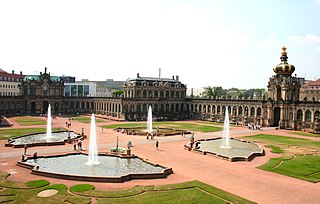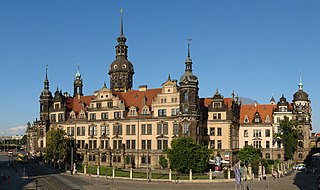
Dresden is the capital city of the German state of Saxony and its second most populous city, after Leipzig. It is the 12th most populous city of Germany, the fourth largest by area, and the third most populous city in the area of former East Germany, after Berlin and Leipzig. Dresden's urban area comprises the towns of Freital, Pirna, Radebeul, Meißen (Meissen), Coswig, Radeberg and Heidenau and has around 790,000 inhabitants. The Dresden metropolitan area has approximately 1.34 million inhabitants.

The Zwinger is a palatial complex with gardens in Dresden, Germany. Designed by architect Matthäus Daniel Pöppelmann, it is one of the most important buildings of the Baroque period in Germany. Along with the Frauenkirche, the Zwinger is the most famous architectural monument of Dresden.

The Dresden Suspension Railway is a suspended funicular located in Dresden, Germany, and connects the districts of Loschwitz and Oberloschwitz. It is one of the oldest suspension railways, having entered service on 6 May 1901, the same year the Wuppertal Schwebebahn entered service. Like the Wuppertal railway, this system was designed by Eugen Langen. The line is 274 metres (899 ft) long and is supported on 33 pillars.

The Dresden Funicular Railway is a funicular in Dresden, Germany, connecting the districts of Loschwitz, near the "Blue Wonder" bridge, and Weisser Hirsch.

The Gemäldegalerie Alte Meister in Dresden, Germany, displays around 750 paintings from the 15th to the 18th centuries. It includes major Italian Renaissance works as well as Dutch and Flemish paintings. Outstanding works by German, French, and Spanish painters of the period are also among the gallery's attractions.

Dresden Castle or Royal Palace is one of the oldest buildings in Dresden, Germany. For almost 400 years, it was the residence of the electors (1547–1806) and kings (1806–1918) of Saxony from the Albertine House of Wettin as well as Kings of Poland (1697–1763). It is known for the different architectural styles employed, from Baroque to Neo-renaissance.

Dresden Hauptbahnhof is the largest passenger station in the Saxon capital of Dresden. In 1898, it replaced the Böhmischen Bahnhof of the former Saxon-Bohemian State Railway, and was designed with its formal layout as the central station of the city. The combination of a station building on an island between the tracks and a terminal station on two different levels is unique. The building is notable for its halls that are roofed with Teflon-coated glass fibre membranes. This translucent roof design, installed during the comprehensive rehabilitation of the station at the beginning of the 21st century, allows more daylight to reach the concourses than was previously possible.

Dresden is a major German city and capital of Saxony. It is a road, train and air transport hub in eastern Germany. Local and commuter transport services grant accessibility in the Dresden agglomeration. The city has a dense network of tram and bus lines. Dresden has two major train stations, an international airport and an inner harbour on the Elbe river waterway. Autobahns grant access to all cardinal directions. Dresden is the junction of two class-A European routes.

The Pillnitz Kleinzschachwitz Ferry, also known as the Schlossfähre, is a ferry across the Elbe river in Germany. It crosses between the districts of Pillnitz and Kleinzschachwitz in the city of Dresden, close to the former's collection of palaces that give the ferry its alternate name. It carries both passengers and cars.

The Dresden tramway network is a network of tramways forming the backbone of the public transport system in Dresden, a city in the federal state of Saxony, Germany. Opened in 1872, it has been operated since 1993 by Dresdner Verkehrsbetriebe (DVB), and is integrated in the Verkehrsverbund Oberelbe (VVO).

The Laubegast Niederpoyritz Ferry is a passenger ferry across the Elbe river in Germany. It crosses between the districts of Laubegast and Niederpoyritz in the city of Dresden.

The Johannstadt Neustadt Ferry is a passenger ferry across the Elbe river in Germany. It crosses between the districts of Johannstadt and Neustadt in the city of Dresden.

The Dresden Porcelain Collection is part of the Staatliche Kunstsammlungen of Dresden, Germany. It is located in the Zwinger Palace.

The Innere Neustadt is a neighborhood in Dresden within the administrative district of Neustadt. The name is derived from "Neue Königliche Stadt", the name given to the former district of Altendresden when it was rebuilt after a fire before 1732. In contrast to the Äußere Neustadt, the Innere Neustadt was within the city fortifications and, for that reason, is also known as the historic Neustadt. Its population is 7,761 (2020).

Pillnitz Palace is a restored Baroque schloss at the eastern end of the city of Dresden in the German state of Saxony. It is located on the bank of the River Elbe in the former village of Pillnitz. It was the summer residence of many electors and kings of Saxony; it is also known for the Declaration of Pillnitz in 1791.

The Schloßplatz is a city square in the center of Dresden, Saxony, Germany. It gets its name from the Dresdner Schloss, the royal residence of the Electors and Kings of Saxony, which faces the south side of the square. The Schloßplatz is further bounded by the Katholische Hofkirche, the Sächsische Ständehaus, the Georgentor, and Augustus Bridge the over the River Elbe. Dating from the 15th century, the square was destroyed in Bombing of Dresden in World War II. In recent years the buildings surrounding the square have largely been restored so that the area again has a historic character.
The following is a timeline of the history of the city of Dresden, Saxony, Germany.

The following outline is provided as an overview of and topical guide to Dresden:

The Dreikönigskirche is a Lutheran church located in the Innere Neustadt of Dresden, Germany. It is the centre of a parish, and a community venue called Haus der Kirche. The church is a listed cultural monument of Dresden.

The Theaterplatz in Dresden is a historic square in the city. It is located in the west of the inner old town.




















